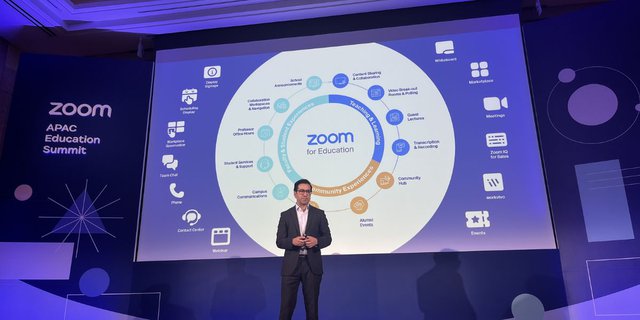Minimalist Edgy Designed Watches, Can Make Your Look More Exciting
OOTD becomes trendier with the use of this aesthetic watch.

Dream - The learning and teaching process continues to evolve with the presence of digital technology. To meet these demands, educational institution managers continue to re-evaluate how they communicate with students.
One of the digital learning alternatives that is present is Zoom. A digital platform that facilitates people from all over the world, from meetings to learning and teaching.
Zoom Video Communications, Inc (NASDAQ: ZM) in the annual event "Zoom Education Summit Asia Pacific" focuses on empowering flexible learning and teaching processes in the rapidly developing education world.
Ricky Kapur, Head of Asia Pacific Zoom, emphasizes the importance of updating the learning and teaching experience to support flexibility. Because digital progress has paved the way for future learning and teaching processes that can change the way we learn, connect, and grow.
For example, smart campus administration, omni-experience student engagement, and interconnected collaborative workspaces.
Each student, teacher, and staff member involved in the hybrid learning and teaching process has different needs. Therefore, educational institutions need to adapt to different learning and teaching environments.
This includes embracing all individuals, whether they are on campus, attending online or hybrid, and adapting to various types of student groups such as large seminars, small groups, and 1:1 mentoring sessions.
Geoff Lambert, Solution Consultant from AARNet, Australia's Academic and Research Network, stated that with the increasing number of universities adopting hybrid learning and teaching processes, the use of collaboration platforms like Zoom can help expand their reach to domestic and international students.
The hybrid approach also makes education more accessible. For example, students with hearing impairments can easily access live captions both on and off campus.
The consistent hybrid approach also adds flexibility, thus supporting part-time students. At the administrative level, Zoom helps educational institutions build resilience and business continuity in the event of disruptions.
Although some people see these changes as challenges, Geoff believes that they provide opportunities for innovative and creative approaches to campus facilities, education, and support services.
Mark Jefferys, Solution Architect at the University of Newcastle, explained that the Higher Education sector faces many challenges in developing student learning experiences in this digital era.
Since partnering with Zoom, they have been able to provide faster and more convenient communication channels for staff and students outside of meetings and lectures, saving time and resources to prioritize the student enrollment and engagement process.
Mark added that since people have become accustomed to the ease of using Zoom, universities can smoothly transition to new Zoom solutions, such as Zoom Contact Center.
At the same time, they can also ensure that students can continue to enjoy a seamless and personalized experience on one integrated platform, consisting of Zoom Meetings, Zoom Phone, and Zoom Contact Center.
Meanwhile, in the annual "Zoom Education Summit Asia Pacific" event, the aspects to consider in providing optimal learning and teaching experiences include:
1. Learning
Teachers must be able to create richer and deeper learning experiences, not just through mixed or online classes.
Teachers can test students' understanding of the material taught through collaborative projects and voting systems, not just through written tests.
2. Connected
Communication outside the classroom is a very important aspect. Students need easy access to their teachers and know the consultation hours available.
At the same time, administrative staff must also stay connected and collaborate with other stakeholders, such as parents and alumni, through organized events.
3. Support
The "connected" and "support" aspects complement each other in creating an ideal learning and teaching experience. Educational institutions must strive to provide students with a seamless learning experience, from recruitment and enrollment to orientation and throughout their time at school.
This includes responding to common questions quickly and efficiently, or easily referring students to the appropriate department when needed.
4. Work
Empowering educational institution staff members is crucial to improving the quality of the learning experience for students. Staff can use technology to work more productively, collaboratively, and avoid information loss during the transition period.
By storing all important information in one easily accessible repository, the workflow of staff members will become smoother. Virtual platforms can connect classrooms with expert speakers from around the world to maximize knowledge sharing processes.
Cobain For You Page (FYP) Yang kamu suka ada di sini,
lihat isinya
OOTD becomes trendier with the use of this aesthetic watch.
Made with sophisticated tailored pieces technique.
Citra appears simple with an all-black outfit while playing tennis.
This white midi-length blazer has a classic cut with pockets on the right and left sides
TECNO Indonesia's Public Relations Manager, Anthoni Roderick, said that the CAMON 20 Series is ready to be a new challenger in the flagship industry with advantages in the camera sector.
Cataracts are the condition of the cloudiness of the lens of the eye, which is usually clear, and the causes are diverse
Sun & Sand Sport opens its first boutique in Indonesia located at PIM 3.
This test drive journey traversed Surabaya-Bromo-Malang and Batu for 500 km over 3 days.
A red velvet dress adorned with beautiful turquoise sequins
Ciki combines a clean white top with stylish high waist cutbray pants.
Curious about what kind of case she's using?
Naarah Joesoef is reportedly in a serious relationship with the handsome racer Sean Gelael. What does Naarah's beauty look like?